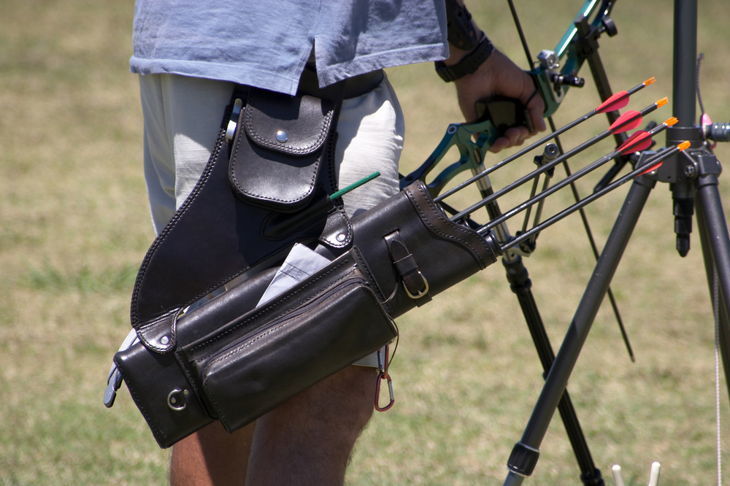How many times have you went hunting and missed a shot, because of the quiver arrows getting in your way, or because you lost sight of your game? We can think of multiple excuses for our poor shots, but let’s face it, it’s not only human error that’s the problem.
Every arrow you shoot is different, despite the build and properties being the same. Since you have to carry these arrows around, often the burden of carrying these arrows around can affect your agility and motion through the surroundings. There are a number of ways of avoiding these problems, that would help you gain your momentum back in hunting.
Hunting requires a combination of decision making skills, such as where to sit and wait, how to approach prey, what gear and accessories should be taken, etc. However, there are some common confusions that might repeatedly bother you every time you go hunting. Deciding the number of arrows is one such problem.
Number Of Arrows Needed While Hunting
When going hunting, if you’re indecisive about which bow to go for, we found a buying guide at Stuffoholics that might help. However, it’s equally important that you decide upon which arrows to use with the bow that you chose in the end.
There are various types of arrows for hunting purposes. Even arrows belonging to a certain type are different from one another. They will each fly in different directions. Each part of an arrow can be tuned depending on the situation you encounter. Before diving into the details of deciding the number of arrows, you should know about the different arrows available based on the type of arrowhead.
- Bullet point: This arrowhead is smooth with a sharp tip. It has a high penetration level and flies fast.
- FIeld point: This arrowhead is a lot like bullet point, but has a wider bottom and lesser penetration capabilities. This feature makes this type of arrow easier to retrieve.
- Judo point: Its tips are much wider. This arrowhead has tiny extensions on the side for ‘gripping’ onto prey. If you miss a shot, it will fall upright. Although it has lower penetration ability, it’s easily retrievable.
- Blunt point: these arrows have blunt, rubber tips, designed to only hurt small game. Since these do not penetrate well, body of prey is less damaged.
- Broadheads: These arrows are exclusively used for hunting, as it contains very sharp blades. This makes the target bleed, and the arrow unretrievable. However, the blades make the arrow flight unstable and your shot less accurate.
Now you should be able to decide the number of arrows you might need. Most bow hunting quivers can carry upto seven arrows. If you want to remain minimal and only hunt deer, you won’t need more than three arrows. The rest of the arrows could be used to hunt small game.
Number of arrows certainly depend on the hunting season and the kind of game available during that season. If it’s specifically deer season and you want to shoot multiple deer you should have at least five arrows ready. Two should be used for bucks and three for does.
Squirrels and coyote hunting is quite difficult since they are small game and move around much faster. A swipe through the bushes can make you think you found a squirrel but you actually shot an arrow at nothing.
For squirrels and coyotes you should keep one or three blunt point arrows in a quiver. Most experts keep six or seven arrows in their hunting quivers. Usually they take more broadheads and one or two judo heads and blunt points.
Carrying Quiver Arrows Around While Hunting
Another difficulty faced while hunting is having to carry the hunting quiver around. Where you keep the quiver is a decision completely on your personal preference. There are many kinds of quivers and you can choose whatever type you want, keeping in mind a few things.
When you move around, the weight of the hunting quiver can affect your speed. Size of the hunting quiver also matters. If it is quite big, you’ll have difficulty hiding behind trees or bushes or climbing trees with it. If the quiver space is big, the arrows may clash against each other, making sounds that can scare prey away. If you crouch, arrows may fall from the quiver which will cause noise and alert surrounding prey.
So as you can see, you will need to determine the right type of hunting quiver for yourself when you head out hunting. Here is a list of the types of quivers you can pick from.
1. Belt Quiver
These quivers are very common. They are quite large, cylindrical quivers attached to a belt on your hips. There are many forms of belt quiver. Some have the quiver suspended in the front while some are suspended from the back hips.

The position of the hunting quiver depends on your personal preference. Some belts come with mini pockets where you can keep some of your accessories. Moving around with these is quite difficult. Chances of arrow falling from these quivers are high, so is the chance of making noise. Adjusting the size of the belt is also a hassle.
2. Bow Quiver
Every hunter wants convenience and bow quiver provides exactly that. It directly attaches to the recurve bow, with the pointed part of the arrow upwards. All you have to do is grab an arrow from the quiver and shoot it, all in the span of a few seconds.

Since the quiver and bow act as a single unit, it frees you from having to carry anything on your body. This also gives you the freedom to carry bags on your back while your quiver and bow are in your hands in the front.
Since the bow and quiver are one unit, the bow will become heavier and that would make your shooting slightly more difficult. While shooting, your precision and accuracy could be affected, since the quiver is attached to the recurve bow in front of you.
3. Back Quiver
This type of quiver is positioned at the back with the help of straps. Thus, chances of quiver dangling from your body and interfering with your movements are low. The nocked ends are at the top, which allows the user to retrieve arrows swiftly over the shoulder using the nock. This allows quick multiple shooting. These arrows can clash with each other and create noise that can scare off prey. Back and belt quivers.

4. Ground Quiver
These quivers are stuck to the ground, allowing the user to shoot arrows from a fixed position. Since it requires less movement and the arrows are within your reach, you can shoot arrows much quicker. However, these can’t be used on tree stands since they won’t stick to wood.
See also: How to Build a Tree Stand for Better Hunting

5. Arrow Bag
Arrow bags are just cloth sacks that can carry arrows, but the arrows are kept separately with a leather spacer. The arrows can be kept fully covered when not in use which would protect them from harsh weather conditions.

Hunters attach arrow bags to their belts or keep them in the ground a bit further from their location. When quivers run out of arrows the hunter can go to the bag and retrieve arrows. Having an arrow bag is definitely a plus point if you want to hunt for a long time. Carrying it around is the only issue.
Wrapping It Up
Bowhunting is a hobby among many people, but it requires a lot of focus, skill and patience. Nevertheless, human beings are prone to mistakes, which is why often we end up missing shots. We miss our much coveted prey and wish we knew better. This is exactly why you should consider thinking of the type of arrows you need and how many you need during hunting.
The next thing you should decide is how you are going to carry your precious arrows around. This is especially important because you don’t want to miss prey and lose your movement at the same time.
Pick quivers that are most comfortable to you and allow you to carry spare arrows in case you need more. Also remember to not pick quivers that are easily identifiable by the prey. By considering these following points, you can ensure that your hunting adventure will be thrilling and memorable for many years to come.


Thanks Mitchell. I got this which one i looked.
Fine way of explaining, and pleasant article to take information concerning
my presentation focus, which i am going to deliver in university.